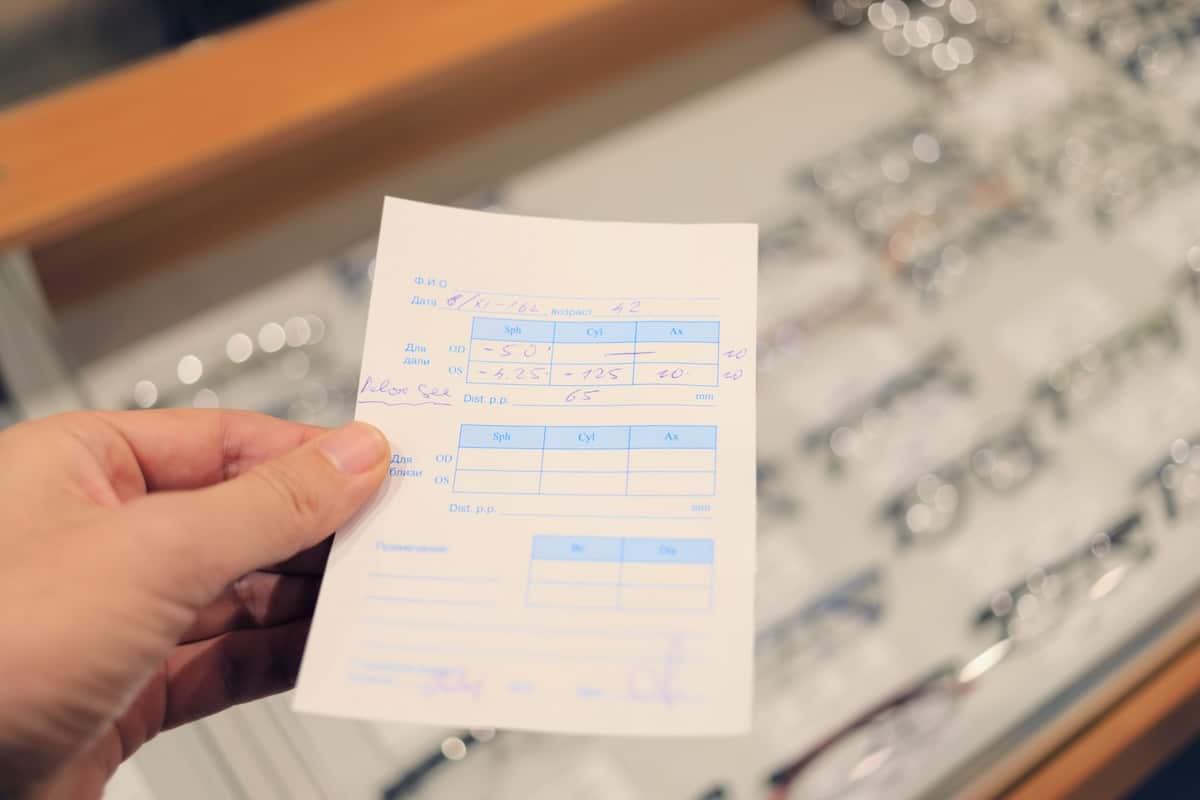Understanding how to read eye prescriptions is essential for maintaining good eye health and ensuring accurate vision correction. In this guide, we’ll break down the components of your prescription and explain what each measurement means, empowering you to make informed decisions about your eye care. Whether you’re new to wearing glasses or simply want to learn more about your prescription, this guide will provide you with the knowledge you need to navigate your vision correction journey with confidence.
Table of Contents
Decoding Your Eye Prescription
Understanding the terms in your eye prescription is key to ensuring accurate vision correction. Here’s a breakdown of some common terms you might encounter when reading your prescription:
- OD, OS, OU: These abbreviations refer to your right eye (OD), left eye (OS), and both eyes (OU), respectively, indicating which eye the prescription applies to.
- NV and DV: NV stands for “near vision,” while DV stands for “distance vision,” indicating the purpose of the prescription—whether it’s for seeing up close or far away.
- PD: The pupillary distance (PD) measures the distance between your pupils, ensuring that your lenses are properly centered over your eyes.
- SPH, CYL, Axis: These terms refer to the lens power (SPH), astigmatism correction (CYL), and its orientation (Axis), respectively, providing precise vision correction for your eyes.
- Prism: Prism correction may be included if you have eye alignment issues, helping to correct double vision or eye strain.
By familiarizing yourself with these terms, you can better understand how to read eyeglasses prescriptions and ensure that your vision needs are met effectively.
Farsightedness vs Nearsightedness
When reading your eyeglasses prescription, it’s important to understand the difference between farsightedness and nearsightedness:
- Farsightedness (Hyperopia): With farsightedness, objects in the distance appear clearer than those up close. In your prescription, farsightedness is indicated by positive numbers, reflecting the additional lens power needed to focus on nearby objects.
- Nearsightedness (Myopia): Nearsightedness causes distant objects to appear blurry, while close-up objects remain clear. In your prescription, nearsightedness is denoted by negative numbers, representing the lens power required to correct the focal point for distant vision.
By recognizing whether your prescription contains positive or negative numbers, you can better understand whether you have farsightedness or nearsightedness and ensure that your eyeglasses provide the appropriate correction for your vision needs.

Understanding Astigmatism
Astigmatism is a common refractive error that occurs when the cornea or lens of the eye has an irregular shape, causing blurred or distorted vision at all distances. Here’s a breakdown of the components of your eyeglasses prescription related to astigmatism:
- SPH (Spherical Power): This measurement indicates the lens power needed to correct nearsightedness or farsightedness, but it does not address astigmatism.
- CYL (Cylinder): The cylinder value represents the additional lens power needed to correct astigmatism. A higher cylinder value indicates a greater degree of astigmatism.
- Axis: The axis specifies the orientation of the cylindrical correction needed to address astigmatism. It is measured in degrees, ranging from 0 to 180.
Understanding these components will help you interpret your eyeglasses prescription accurately and ensure that your lenses provide the appropriate correction for astigmatism, resulting in clearer and sharper vision.
Does Your Eye Prescription Change?
Eye prescriptions can change over time due to various factors, including age, health conditions, and lifestyle changes. This is why it’s imperative to know how to read eye prescriptions. Here’s what you need to know:
- Age-related Changes: As you age, your vision may change, often resulting in the need for updated prescriptions. This is particularly common for individuals over 40 who may experience presbyopia, a condition that affects near vision.
- Health Conditions: Certain health conditions, such as diabetes or hypertension, can impact your eye health and lead to changes in your prescription. Regular eye exams are essential for detecting and monitoring any changes in your vision.
- Lifestyle Factors: Factors like prolonged screen time, exposure to environmental pollutants, or changes in your daily activities can also affect your vision and may necessitate adjustments to your prescription.
By staying proactive about your eye health and scheduling regular eye exams, you can ensure that any changes in your prescription are detected early and addressed appropriately, allowing you to maintain optimal vision and eye health over time.

Are Eyeglass Prescriptions the Same for Contact Lenses?
While eyeglasses and contact lens prescriptions serve the same purpose of correcting vision, they are not interchangeable. Here’s what you need to know:
- Differences in Measurement: Eyeglass prescriptions include measurements specific to the distance between your eyes and the frames, while contact lens prescriptions focus on parameters related to the curvature and fit of the lenses directly on the eye.
- Additional Parameters: Contact lens prescriptions may include additional parameters such as base curve and diameter to ensure proper fit and comfort on the eye, which are not present in eyeglass prescriptions.
- Consultation with Eye Care Professional: It’s essential to have separate eye exams for eyeglasses and contact lenses to ensure accurate prescriptions for each. Your eye care professional will assess your visual needs and lifestyle factors to determine the most suitable prescription for your chosen vision correction method.
By understanding the differences between eyeglasses and contact lens prescriptions and consulting with your eye care professional, you can ensure that your vision correction needs are met effectively and safely.
How Can I Get My Eye Prescription?
Getting your eye prescription is a straightforward process that ensures you have accurate vision correction. Here’s how:
- Schedule an Eye Exam: The first step is to schedule an appointment with an eye care professional, such as an optometrist or ophthalmologist, for a comprehensive eye exam.
- Comprehensive Eye Exam: During the eye exam, your eye care provider will perform various tests to assess your visual acuity, eye health, and any refractive errors, providing you with an updated prescription if needed.
- Request Your Prescription: Once your eye exam is complete, don’t forget to request a copy of your prescription from your eye care provider. They are required by law to provide it to you upon request.
- Online Prescription Renewal: In some cases, you may be eligible for an online prescription renewal through telemedicine platforms, allowing you to obtain a prescription from the comfort of your home.
By following these steps, you can easily obtain your eye prescription and ensure that your vision correction needs are met accurately and effectively.
Schedule Your Eye Exam
Ready to see the world with clarity? Look no further than Michigan Eye Institute for your comprehensive eye exam. Our dedicated team ensures personalized care and accurate prescriptions to optimize your vision. Don’t miss out—take the first step towards sharper vision and healthier eyes by scheduling your eye exam today.
Comments are closed.



